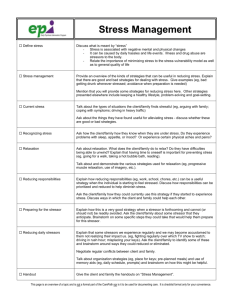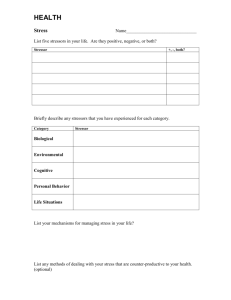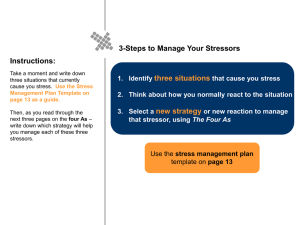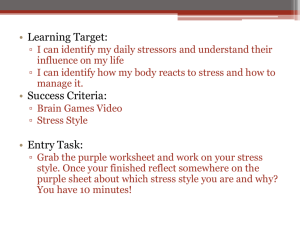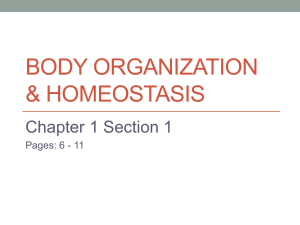EXERCISE TO REDUCE STRESS IN THE WORKPLACE
advertisement
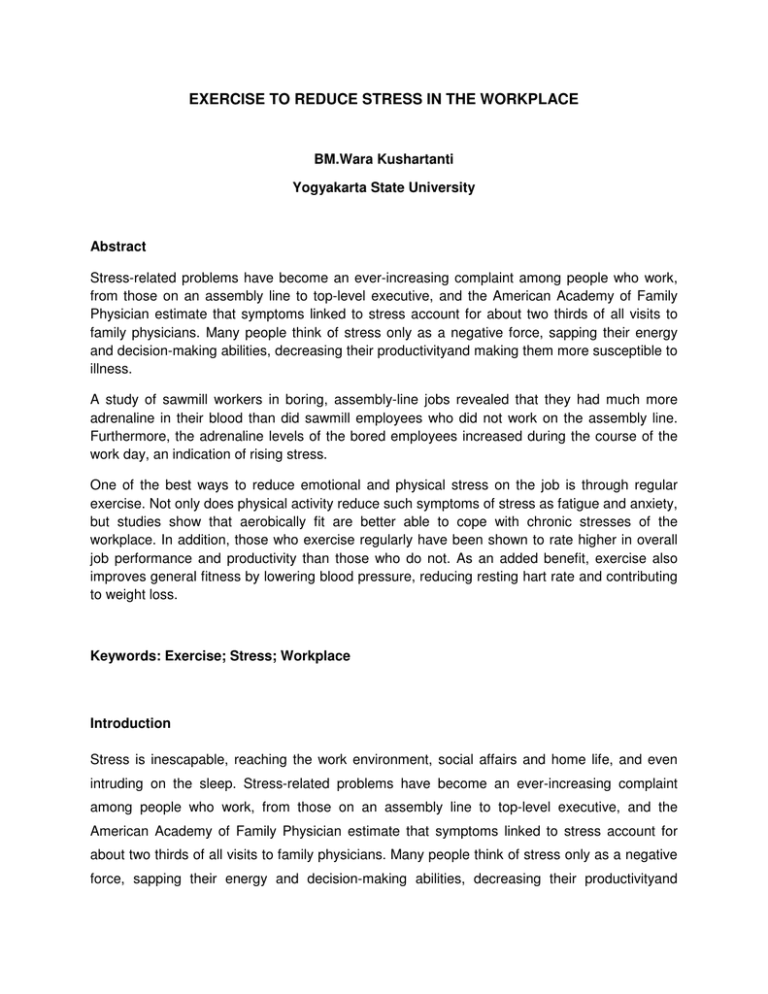
EXERCISE TO REDUCE STRESS IN THE WORKPLACE BM.Wara Kushartanti Yogyakarta State University Abstract Stress-related problems have become an ever-increasing complaint among people who work, from those on an assembly line to top-level executive, and the American Academy of Family Physician estimate that symptoms linked to stress account for about two thirds of all visits to family physicians. Many people think of stress only as a negative force, sapping their energy and decision-making abilities, decreasing their productivityand making them more susceptible to illness. A study of sawmill workers in boring, assembly-line jobs revealed that they had much more adrenaline in their blood than did sawmill employees who did not work on the assembly line. Furthermore, the adrenaline levels of the bored employees increased during the course of the work day, an indication of rising stress. One of the best ways to reduce emotional and physical stress on the job is through regular exercise. Not only does physical activity reduce such symptoms of stress as fatigue and anxiety, but studies show that aerobically fit are better able to cope with chronic stresses of the workplace. In addition, those who exercise regularly have been shown to rate higher in overall job performance and productivity than those who do not. As an added benefit, exercise also improves general fitness by lowering blood pressure, reducing resting hart rate and contributing to weight loss. Keywords: Exercise; Stress; Workplace Introduction Stress is inescapable, reaching the work environment, social affairs and home life, and even intruding on the sleep. Stress-related problems have become an ever-increasing complaint among people who work, from those on an assembly line to top-level executive, and the American Academy of Family Physician estimate that symptoms linked to stress account for about two thirds of all visits to family physicians. Many people think of stress only as a negative force, sapping their energy and decision-making abilities, decreasing their productivityand making them more susceptible to illness. Yet researcher have shown that stress also has a positive side, and that in fact some stress is necessary for functioning effectively and living a full life. Wether stress has a mostly positive or negative impact on someone depends on how someone perceive and respond to stressful situations. Recognizing stress and then coping with it successfully are processes that we can learn (Barnes, 2004) There is no simple definition of stress. The term has been used by researchers and the public alike to refer to both the effects of stress and to stressors, which are events or conditions that produce stress. In general, though, stress can be thought of as the perception that events or circumstances have challenged, or exceeded, a person’s ability to cope. This emphasizes the lesson that stress researchers have learned repeatedly, which is that stress occur within each individual and is determined by his or her particular characteristics. This helps explain why some events, a deadline at work, for example can almost paralyze one person but inspire another . Our reactions to stressors can be divided into two broad categories: psychological and physiological. On the psychological level, we often respond to stressors unpredictably, as variations in our moods and emotions trigger changes in our behavior, ranging from expressions of anger to patterns of alcohol or drug use. The psychological reaction to a stressor is dependent on many factors, including the emotional state at the time and how troublesome the perceive the stressor to be. The biochemistry of stress is more predictable than the psychological response. A stressor sets in motion a series of biochemical and neurological changes that is much the same regardless of the stressor that provoked it. How does the body respond to stress? Although the situations or events that elicit stress vary from one person to another, physiologists have long known that people undergo the same general response to stress. This reaction is what Hans Selye, a pioneer in researching the physiology of stress, called the General Adaptation Syndrome. Selye believed that this syndrome is a response to almost any stressor. According to Selye, the syndrome occurs in three stages: alarm, resistance and exhaustion. The alarm stage produces changes in the brain and endocrine system. Perhaps the most dramatic and best known of these physiological responses is the group of reactions called the fight-orflight response. The fight-or-flight response named by physiologist Walter B.Cannon that include swings the body into physiological high gear in preparation to confront a threat, escape from it or try to repair injuries. The response is triggered by the sympathetic nervous system, which stimulates a discharge of the stress hormones epinephrine (adrenaline) and norepinephrine (noradrenaline) from the adrenal glands. These two hormones prepare the body for action and help produce a wide reang of changes in the body, including a near-shutdown of the digestive system, improved visual perception and muscle response, and increased blood pressure, blood sugar and cholesterol levels, and breathing and heart rates. If a stressor persists for more than a brief time, the body adapts to it by entering the state of resistance. During this phase the body’s system return to normal, but they remain alert to respond to the stressor. If the stressor is intense or long-lasting, the body eventually enters the third and final stage, exhaustion, at which point it can no longer resist the stressor and becomes vulnerable to dysfunction and disease. When we are in a threatening situation, the fight-or-flight response is clearly useful. It may also serve us when confronting a non threatening challenge, as in an athletic competition or meeting a deadline at work. But in modern society, the fight-orflight response is often provoked when it is neither needed nor useful, in an argument, for example, or while we are waiting in a long line at the bank or at a supermarket checkout counter. Our body is in a heightened state, but it has no way to release its pent-up energy. And without alternative methods of coping with stress, stiflling the alarm reaction can be physically and psychologically damaging. In studying the effects of stress, researchers have determined that the impact of a stressor depends to a great extent on our perception of its frequency and duration. An acute stressor is immediate and identifiable, such as waiting to see a dentist or making an important speech. After we have dealt with this source of stress, we relax temporarily and the proceed to other tasks. As long as you can cope with each acute stressor as it arises, stress remains short term and manageable. Acutely stressful situation, however, can accumulate to cause long-term stress. A cluster of stressors may occur in such rapid succesion that we don’t have enough time to adapt. For example, a deadline is moved up at our office just as a valuable employ leaves. Or a stressor can be intermittent, occuring on a more or less regular basis that we have little control over, such as driving to work in rush-hour traffic. Finally there are chronic stress conditions, which are the result of such constant stressors as a disabling illness or a persistent tensions at home or at work The Warning Signals for an Overload of Stress. Signals that we are under too much stress range from general malaise to physical pain. These symptoms are so wide-ranging that people often do not recognize them as signs of stress. They include emotional responses such as overreacting to minor problems, inappropiate anger or impatience, overeating or loss of appetite, and increase use of alcohol, tobacco or drugs. If we are suffering from stress overload, we may feel anxious, be unable to relax or experience long periods of boredom. Stress can also disrupt sleeping patterns, sexual activity and performance at work. Under stress, many people show a diminished ability to set priorities and make decisions. They attack tasks with less certainty and make more mistakes. In one study of college students, for example, researcher imposed high stress on subjects taking a test. Not only did it take much longer for the students to complete the test, but their error rate rose dramatically as well. Finally, stress overload may manifest it self in physical symptoms such as headaches, coldhands or feet, indigestion, aching neck or back, ulcers, nausea, diarrhea or constipation, shortness of breath, heart palpitation, teeth grinding, muscle spasms and skin conditions like acne and psoriases. Person under stress also lose more time from work due to illness. Stress appears to influence a wide range of diseases and disorders. The most crucial response in this respect may be the suppression of the body’s immune response. In one study, for example, during stressful examination periods, antibody levels in students were found to be lower than normal, indicating a greater vulnerability to infection. Other studies have shown that aggressive Type A personalities catch more colds than their more relaxed counterparts. Many studies have found a strong connection between heart disease and stress, especially in Type A personalities. Moreover, other studies have suggested a link between high cholesterol levels, a contributing factor in heart disease, and occupational stress. Many ailments of the stomach and intestinal tract are strongly influenced by one’s emotional state. Likewise, headaches and backaches have long been linked to stress. In one study comparing a headache-prone group with a headache-free group, the headache sufferers showed a significantly higher stress response following a test. And in a study comparing chronic back-pain sufferers with healthy subjects, the backache sufferers tested higher on all measures of stress. Stress also appears to be linked with many skin disorders. In a recent study, psoriasis sufferers showed higher levels of stress hormones than healthy subjects when subjected to stressful tests. Evidence is accumulating that stress may pose a special threat to people with chronic hypertension. In one study, both hypertensive and borderline hypertensive subjects showed higher levels of stress hormones when given a word-matching test than did subjects with normal blood pressure. Medical research has also begun to reveal the links between stress and sexual problems. In one study, for example, men who experienced the least arousal when viewing erotic movies had the highest levels of stress hormone cortisol (Black, 1979). The effect of Quick Relaxation Technique on dizziness could be explained by 20% reduction of oxygen consumption and increased CO2 production during meditation including Quick Relaxation Techniques (Wilson, 2003) resulting in better supply of oxygen to the brain. The disappearance of tension on the back of the head and shoulders was due to the relaxation effect. Meditation include Quick Relaxation Techniques stimulate alpha waves which present in a relaxed and full awareness state. At the same time, the delta waves commonly present during a deep sleep also present during meditation (Krishna, 2000) suggesting that during meditation full consciousness and relaxation coexist. Alertness is enhanced by the release of epinephrine, while relaxation is the result of endorphine hormone. The sympathetic nervous system arousal also reduced by Quick Relaxation Techniques, so that the heart rate and breathing rat slow down (Jaffe, 1980). Anxiety was reduced after Quick Relaxation Techniques due to the opposite effect of “fight or flight” in a person under stress. Quick Relaxation Techniques was recommended for persons with hypertension to manage stress in their daily lives. Better blood flow and decrease in metabolic rate improve peripheral blood circulation so that tissue perfusion will be better (Walton, 2002). Getting to Work Stretching A harried commute or a pressing deadline, and stress is all too often a part of the working day. Unlike morning stress, which tends to be generated internally, much job related stress comes from external for us that are difficult to control. A major study of 657 white and blue collar workers at a large automobile factory identified four factors that can lead to stress in the workplace: overload, which may include a heavy volume of work and restrictive rules; low job satisfaction; little influences over one’s work situation; and conflicts with co-workers and supervisors. Poor motivation and fatigue can sometimes be traced to monotonous and impersonal jobs. A study of sawmill workers in boring, assembly-line jobs revealed that they had much more adrenaline in their blood than did sawmill employees who did not work on the assembly line. Furthermore, the adrenaline levels of the bored employees increased during the course of the work day, an indication of rising stress. And those who rated lowest in job satisfaction found it difficult to relax after work and tended to have the highest absenteeism, with problems ranging from chest pains to depression. Not all of stresses are caused by the emotional factors of a job. Indeed, a person maybe perfectly happy at his job and still suffer from stresses caused by environmental condotions, such as poor lighting and ventilation, excessive noise and inadequate or excessive heating. One of the best ways to reduce emotional and physical stress on the job is through regular exercise. Not only does physical activity reduce such symptoms of stress as fatigue and anxiety, but studies show that aerobically fit are better able to cope with chronic stresses of the workplace. In addition, those who exercise regularly have been shown to rate higher in overall job performance and productivity than those who do not. As an added benefit, exercise also improves general fitness by lowering blood pressure, reducing resting hart rate and contributing to weight loss. Some corporations have experimented with exercise program as away to increase productivity and reduce sick leave and corporate health-care expenditures. The results of one such study showed that adherence to an exercise program boosted worker productivity and reduced absenteeism. In another study, the Prudential Insurance Company conducted a five-year survey of 1,389 office workers, most of whom had sedentary jobs. Those employees who engaged in a corporate physical fitness program showed a 46 percent reduction in major medical costs annually, and a 36 percent reduction in disability days. After five years, Prudential realized a savings of $1.93 for each $1.00 invested in the fitness program. Not all companies offer comprehensive fitness programs, of course; however, even short stretching routines to loosen up after long periods of sitting can releive stress, according to several studies. A commuter deals with a multitude of stressors. Studies on animals show that even a slight environmental change is enough to alter hormone levels in the blood and increase other chemical signs of stress. In addition to the stress of simply moveing from one place to another, travel presents environmental stress in the form of automobile exhaust, vibration and noise, such physical stresses as the discomfort of sitting or standing in a cramped space, and the psychplogical stresses of uncontrollable delays like traffic jams. Driving is particularly stressfull for many people because it exposes them to most, ifnot all, of the above stresses, with the additional burden of having to to concentrate, particularly when driving at high speeds, in heavy traffic or in bad weather. Driving can result in a faster heart rate, increased hormone production, elevated blood pressure, sweating, nervous and muscular tension, gastrointestinal disturbances and other physiological signs of stress. One of easiest way to reduce the stresses of commuting is stretching routines. Stretching will releive tension in the neck, shoulder, and back muscles, which can become cramped when one remain in the same position for an extended period. Perform the exercises below while seated in a bus, train, or plane, or while stopped at a light or stalled in traffic in the automobile. Hold each stress for 20 seconds. 1. Grip the steering wheel or the seat in front of you to steady your shoulders. Turn your head to the right, stretching your neck muscles. Then turn to the left. 2. Keeping your shoulders steady, drop your head to the right, bringing your ear toward your shoulder. Repeat on the left. 3. Bring your right hand up and draw it across your body to stretch your right shoulder. Repeat for the left shoulder. 4. Raise your right hand over your head and draw your right arm and shoulder back into a stretch. Repeat on the left side. 5. Intertwine your fingers behind your neck and bring your elbows as far back as possible. Keep your neck straight. 6. Place your hands against the dashboard or the back of the seat in front of you. Extend your arms and push your back in to the seat. Deskbound Stretching. Some of the most stressfull jobs involve sitting at the desk all day. In a study by the National Institute for Occupational Safety and Health, secretaries, managers and administrators were among those who suffered the highest rate of such stress-related illnesses as hypertension and heart attack. But being deskbund need not prevent you rom taking a few minutes out of even the busiest day to reduce tension. In less than 15 minutes, you can perform the comprehensive relaxation routine as below. This e not prevent you rom taking a few minutes out of even the busiest day to reduce tension. In less than 15 minutes, you can perform the comprehensive relaxation routine as below. These exercise will serve to reduce stress by focusing your mind on something other than anxiety-provoking job pressures. Simple distraction, studies show, can significantly reduce your level of anxiety. Of equal importance, this routine will work to releive the physical symptoms of stress, such as rapid, shallow breathing and muscular tension. Don’t bounce or jerk as you perform these stretches; do them slowly and deliberately. Be sure to breathe deeply and evenly, but never force your breath. For best results, hold each stretch for 10 to 20 seconds, relax, and then repeat once or twice. 1. Releive tension in your fingers and hands by extending your arms in front of you and spreading your fingers 2. One by one, touch each finger to your thumb 3. Interlace your fingers and grasp the back of your head. Then drop your chin toward your chest and push down with your hands until you feel a stretch in the muscles along the back of your neck. 4. Extend your arms sideways so that they are parallel to the floor. Flex your hands so that your fingers point up and make circling motions with your hands and arms. 5. Place your palms together in front of you, fingers pointed up. Press your hands together hard for fiveseconds, then relax. Repeate three times. 6. Rest your hands on your desk and look straight ahead. Close your eyes, drop your jaw and open your mouth as wide as you can. Keep your face relaxed. 7. Close your mouth and grimace. Relax your jaw, but tighten your lips and shut your eyes. Alternate this exercise several times with jaw opener at left. 8. Turn your chair away from your desk and sit up straight. Drop your right hand toward the floor and extend your left hand toward the celling, stretching your entire left side. Repeat on your right side. 9. Brace yourself by holding the sides of your chair. Keeping your left foot flat on the floor, extend your right leg out parallel to the floor and flex your foot, stretching your harmstrings. Repeat for your left leg. 10. Stand up and take a deep breth. Tilt your head back and throw out your arms as if you were greeting the celling. 11. Exhale as you slowly relax your body, bending your knees slightly and dropping your hands to the floor. Remain bent over for a few seconds before slowly taking a deep breath and returning to the greet-the-celling pose. References Barnes FA, Triber FA, Johnson MH; Impact of Transcendental Meditation on Ambulatory Blood Pressure in African American Adolescence, The American journal of Medicine 17:366369, 2004 Black HR; Nonfarmacologic Therapy for Hypertension, The American journal of Medicine 66: 837-842, 1979 Jaffe,DT; Healing from Within, Simon and Schuster,Inc, New York, 1980 Krishna,A; Ilmu Medis dan Meditasi, PT Gramedia Pustaka Utama, Jakarta, 2000 Walton KG, Schneider RH, Nidich SI; Psychosocial Stress and Cardiovascular Diseases 2: Effectiveness of the Transcendental Meditation Technique in Treatment and Prevention. Behavior Medicine 28:106-123, 2002 Wilson,P; Teknik Hening: Meditasi tanpa Mistik, Erlangga, Jakarta, 2003
